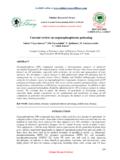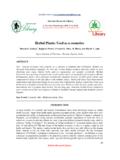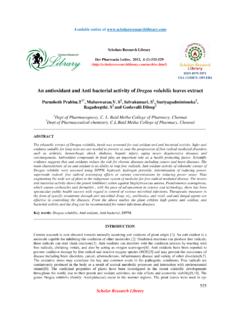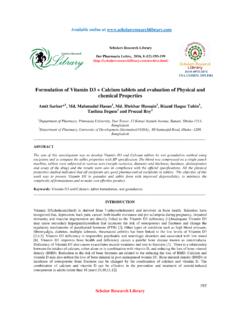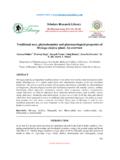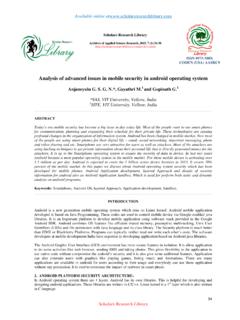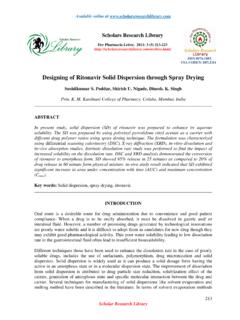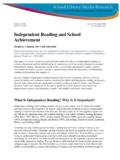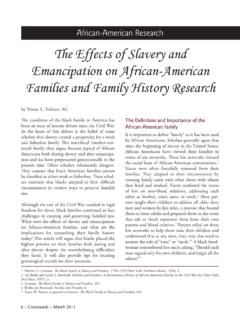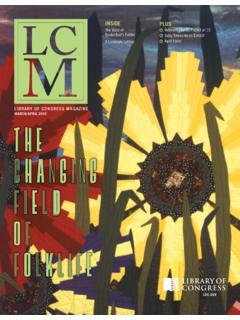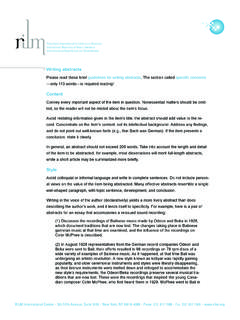Transcription of Quantitative estimation of tannins by HPLC
1 Available online a scholars research library Der Pharmacia Lettre, 2016, 8 (3):123-126 ( ) ISSN 0975-5071 USA CODEN: DPLEB4 123 Scholar research library Quantitative estimation of tannins by HPLC Trupti P. Durgawale1, Pratik P. Durgawale2 and Chitra C. Khanwelkar3 candidate, Department of Pharmacology, Krishna Institute of Medical Sciences Deemed University, Karad, Maharashtra, India 2 research Officer, Molecular and Genetics Laboratory, Krishna Institute of Medical Sciences Deemed University, Karad, Maharashtra, India 3 Professor and Head of Department, Department of Pharmacology, Krishna Institute of Medical Sciences Deemed University, Karad, Maharashtra.
2 India _____ ABSTRACT A High Performance Liquid Chromatography method has been developed and Quantitative estimation of tannins in Pueraria tuberosa (Fabaceae) using aqueous extract, very simple method has been performed. Nucleosil C18 column was used with methanol (HPLC Grade) and water as mobile phase with ratio (50:50) with pH , at flow rate of 1 mL/min, UV detection performed at 270 nm. Total run time was 12 min and tannic acid was eluted at retention time of minute. Calibration plots of tannic acid standard were linear over concentration range 0-60 g/mL with respect to the mean area.
3 Keywords: Pueraria tuberose, tannins , HPLC _____ INTRODUCTION Pueraria tuberosa (Roxb. ex Willd. DC, family: Fabaceae) is a perennial climber found throughout the Indian subcontinent in wet and damp areas. The tuberous roots of this plant are used in Indian traditional medicine (Ayurveda) in general debility, nervous breakdown, spermatorrhoea, burning sensation, heart diseases, intrinsic hemorrhage, tuberculosis etc. The chemical constituents have been identified as puerarin, diadzein, daidzin, -sitosterol and sigmasterols.
4 Puerarin (isoflavones) has been reported to possess anti-fertility, anti-hypertensive, anti-hyperglycemic, nootropic, and neuroprotective effects [1]. Considering the varied important activities reported in traditional system of medicine with this plant, it was planned to study the effects of tubers extracts of P. tuberosa DC for its antidiabetic activity [2]. tannins (commonly referred to as tannic acid) play an important role and have wide applications. tannins are water-soluble polyphenols that are present in many plant foods.
5 They have been reported to be responsible for decrease in feed intake, growth rate, feed efficiency, net metabolizable energy, and protein digestibility in experimental animals. Therefore, foods rich in tannins are considered to be of low nutritional value. However, recent findings indicate that the major effect of tannins was not due to their inhibition on food consumption or digestion but rather the decreased efficiency in converting the absorbed nutrients to new body substances.
6 The anti-carcinogenic and anti-mutagenic potentials of tannins may be related to their anti-oxidative property, which is important in protecting cellular oxidative damage, including lipid peroxidation. The anti-microbial activities of tannins are well documented. The growth of many fungi, yeasts, bacteria and viruses was inhibited by tannins . It has also been reported that tannic acid and propyl gallate, but not gallic acid, were inhibitory to food-borne bacteria, aquatic bacteria and off-flavor-producing microorganisms.
7 Their anti-microbial properties Trupti P. Durgawale et al Der Pharmacia Lettre, 2016, 8 (3):123-126 _____ 124 Scholar research library seemed to be associated with the hydrolysis of ester linkage between gallic acid and polyols hydrolyzed after ripening of many edible fruits. tannins in these fruits thus serve as a natural defense mechanism against microbial infections. tannins have also been reported to exert other physiological effects, such as accelerating blood clotting, reducing blood pressure, decreasing the serum lipid level, producing liver necrosis, and modulating immunoresponses [3].
8 MATERIALS AND METHODS Tannic Acid (analytical grade), methanol and water (HPLC grade) were purchased from S D fine chemicals, Mumbai and tuber of Pueraria tuberosa was provided as a gift sample by Mr. Vivek Gourbroom. Preparation of extract: Aqueous Extract About 100 g of tuber powder was taken in a round bottom flask (2000 mL capacity) and macerated with 500 mL distilled water and 10 mL of chloroform as preservative for 24 hr with occasional shaking every hour; then the marc was removed by filtering the extract, and was concentrated on water bath at 50 C.
9 It was then kept in refrigerator below 4 C till experimental study. Preparation of mobile phase The mobile phase was prepared by mixing methanol and water in ratio of 50:50 and filtered through m filter, using vacuum pump and sonicated for 30 min [4, 5, 6]. Preparation of calibration curve of tannic acid Tannic acid (10 mg) was dissolved in 10 mL of mobile phase to prepare stock solution with concentration of 1000 g/mL. A series of dilutions with concentration of 20, 30, 40, and 50 g/mL were prepared by taking aliquots of , , , and mL of stock solution (1000 g/mL) and diluted up to 10 mL with mobile phase.
10 Each dilution (20 L) was injected with the help of a syringe in triplicate and the area under curve at 270 nm was recorded. Calibration curve of mean area against concentration was plotted (Figure 1). Preparation of sample 10 mg sample was dissolved in 10 mL of mobile phase and allowed to stand for 8 hr with occasional stirring and filtered through m filter and sonicated for 30 min. Quantification was carried out using an absolute calibration curve method with standard solutions of Tannic acid.
